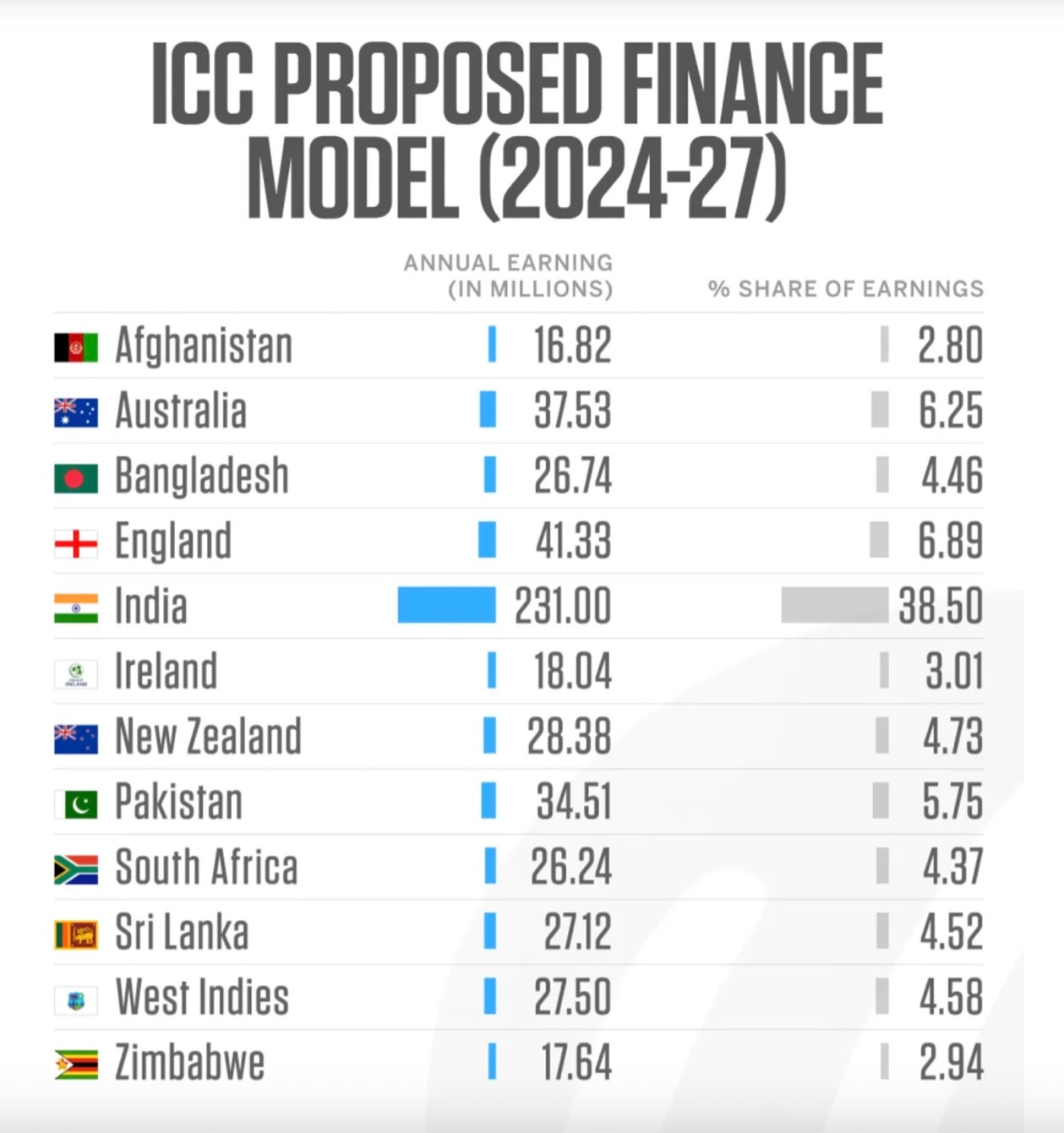Why Zimbabwe play more Tests than Ireland
Ireland are due to play three Tests this year, eight fewer than Zimbabwe despite similar ICC funding. What gives?

Inevitably, the bar at Clontarf Cricket Club provided ample entertainment for a rain delay during Ireland’s ODIs against the West Indies. Barely seconds after entering, a disgruntled punter approached. He had a burning question. A journo seemed as good a place as any to find an answer.
“How do Zimbabwe, on less ICC money than Ireland, play so much more Test cricket than us?”
Zimbabwe will play 11 Test matches, eight at home, in 2025. Provided FTP commitments are fulfilled, Ireland will play three, all away (a February win in Zimbabwe is supposed to be followed by two red ball games in Bangladesh this winter). The positive press the African nation has received for prioritising long form cricket has been off the charts, even if there are legitimate questions on financial sustainability.
The semi-disgruntled punter then took out his phone. When the new ICC funding cycle for 2024-2027 was revealed by Cricinfo nearly two years ago now, a helpful graphic was released, showing each country’s allocation. Our fan in question was able to pull it up within seconds. There, in stark simplicity, was the financial picture.
Ireland was set for $18.04 million annually, Zimbabwe $17.64 million. How can a country receiving less money than us play close to four times the amount of Test cricket?
Our muse for this story requested a simple breakdown, in bullet point form if possible. We’ll start there before explaining some of the nuances of the situation.
Neither Ireland nor Zimbabwe received as much as advertised above, thanks to the ICC’s practice of withholding income to protect against funding falling in the next cycle
Prior to 2024, Cricket Ireland received as much 75% less income from the ICC than Zimbabwe Cricket (in certain years)
ZC spent close to $3 million less than CI on player and staff salaries
The average salary in Zimbabwe is as much as $40,000 lower than the Irish equivalent
CI is currently repaying a $5 million loan to the ICC. ZC has no similar liability
Cricket infrastructure costs are more than half in Zimbabwe what they are in Ireland
ZC is on record as having a different attitude towards red ball cricket to Ireland
Let’s reverse the batting order and start with the final point. As part as the aforementioned positive press, Tavengwa Mukhulani, ZC’s chair, made his attitude towards Test cricket abundantly clear to Cricinfo: "I believe that every Full Member must play all three formats. It's part of our eligibility criteria."
CI’s leadership has not been as unequivocal. Infamously, ahead of the 2023 Lord’s Test against England, then CI performance director Richard Holdsworth said that game was not a “pinnacle event” for Ireland. In terms of on-field significance, he was right. The World Cup qualifiers less than a fortnight later were more important. That didn’t stop the English press from gleefully accepting that gift-wrapped headline. The ECB were not amused.
More recently, CI CEO Warren Deutrom made clear his belief that the drive to push smaller governing bodies into Test cricket should come from the ICC. "I think the way it would work is that you would incentivise the boards in order to make sure that the players could be incentivised," he said to the BBC.
"Every member deals with its players differently, incentivises different formats. Obviously we are very familiar with the approach England takes in terms of the incentivisation of its players to play Test cricket."
There is a clear difference in how the two nations view their responsibility. Zimbabwe see themselves as duty bound to play Test cricket. It is what comes from ICC full membership, the very status which drives their funding figure. By contrast, Cricket Ireland views regular Tests as the responsibility of the ICC. If they want Ireland to play more Tests, they need to help pay for it.
Deutrom’s comments, specifically about incentivising players, seem slightly curious in that they suggest that Ireland’s cricketers are not currently incentivised to don the whites. Josh Little is the only Irish player who has focused on white ball as opposed to Test cricket, and he remains committed to playing for Ireland (CI still has a degree of control over his career, with the powers that be reluctant to let him play for Middlesex in recent T20 fixtures against Essex and Surrey due to injury concerns).
No other Irish player is turning down Test cricket in favour of white ball - be it franchise or international. The issue isn’t Ireland convincing their players to pick up a red ball, but rather CI’s ability to pay for it. Deutrom is right that he needs more money, but for the wrong reasons.
Now for the financials.
The question surrounding Cricket Ireland in its second year of this improved ICC funding cycle is, where is the new money going if not on international (read, Test) cricket? In the context of this comparison to Zimbabwe, such a concern, while still valid, ignores the context of what happened pre-2024.
In 2023, CI received just under €4 million from the ICC. This rose to €12.6 million in 2024, year one of the new cycle (again, that figure was lower than what Cricinfo reported because of the ICC’s withholding policy).
ZC only has accounts up to 2022 available on its website. This creates an imperfect comparison, but according to the most up to date figures, they received $11.8 million (€10.2 million at today’s exchange rate), more than double what CI took home in 2023.
Granted, in 2023, CI’s total income was €4 lower than in 2022. The decrease came because of less ICC money. Did CI come closer to ZC in 2022 with a more generous ICC? Yes. Equal? Almost certainly not.
Combine all of this with CI’s $5 million loan which is currently being repaid (plus interest) to the ICC. In 2024, a payment of €1.3 million was made. That is the cost of a hosting Test match and then some. ZC’s liability figure in 2022 totalled $370,000.
Add to this the economic factors in the two countries. Finding trustworthy figures on working conditions is difficult, but multiple outlets say the average salary in Zimbabwe is around $3,000. In Ireland, again depending on which outlet you go to, the equivalent figure is €45,000/$51,000.
Does such a discrepancy account for CI’s significantly higher wage bill? In 2024, the Irish governing body spent €6.5 million ($7.5) on players, umpires and administrative staff. In 2022 (again, an imperfect comparison but it’s all we’ve got), ZC spent $4.7m on player contracts and staff.
Annoyingly, while CI’s books show how many people (including casual players and officials taking home only match fees) were on the books, ZC’s doesn’t. So while we know that CI pays its people a few hairs shy of $3 million more, we don’t know if that’s because of a bigger workforce, increased wages, higher cost of living or all of the above.
What we do know is that in 2018, ZC spent just over $445,000 hosting two Tests against Sri Lanka. In that same very year, Ireland’s first ever Test at Malahide led to an expenditure of just over €900,000 ($1.04 million) in the books. Zimbabwe have grounds that don’t need temporary changing rooms and stands in the same way Malahide does, and they probably pay those working around Test cricket less than CI does. It is still staggering, though, that they could host two Tests for less than half the cost of one Irish red ball game.
None of the above analysis answers if playing so much or little Test cricket is a good idea. ZC has been widely lauded for their ambition, but they still got hockeyed by England at Trent Bridge earlier this summer. Maybe next year, after a 2025 full of red ball cricket, will be a better time to assess their elevated (or otherwise) skill levels. The accounts for this year, if and when they were published, will certainly make for fascinating reading to see if this was all financially worth it.
Ireland, by contrast, despite no First Class set-up (Zimbabwe does have one and spent roughly $209,000 on the competition in 2022) fared marginally better in their equivalent England fixture at Lord’s in 2023: a 10-wicket thumping compared to an innings defeat. They’ve also beaten Zimbabwe twice, home and away, in the last 12 months.
Off the pitch, the financials of both countries explain pretty clearly why ZC have gone all in and Ireland have folded. Combine that with differing governance ideologies towards red ball cricket and the answer to the question posed in the Clontarf bar become clear.
Whether either governing body is ‘right’, given their differing circumstances, is another question entirely. The clamouring of the Irish cricketing public for more red ball games suggests they agree with Mukhulani’s logic; full members should play Test matches. Figure out the consequences later.
CI would, no doubt, argue they are taking the more financially prudent path. They probably are, but one suspects that there must be a happy middle ground, a third option between Zimbabwe’s feast and Ireland’s famine, one which gets the public more on board with Cricket Ireland’s leadership.



Great to get clarification and insight into a very important question from that punter in Clontarf. Thanks Nathan
Looking at next year's FTP Ireland are due to play 2 Tests 6 ODI’s and 6 T20’s which seems are reasonable quantity especially when considering the degree of player overlap between the 3 formats
The only question will be will the new regime ensure these fixtures happen?